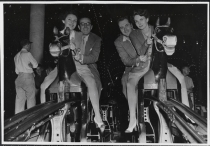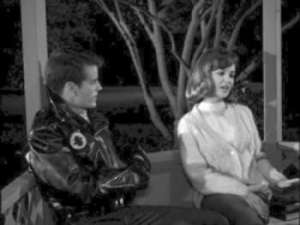There was a joke that used to go something like this: What kind of beer did the Doctor recommend to the woman who was going to have twins? Answer: Schaefer, because it’s the one beer to have when you’re having more than one.
If you’re of a certain age and lived in the New York Metropolitan area, you remember this little bit of advice because it was oft repeated in highly polished ads like this:
In the nineteen sixties and early seventies, it was the rare New York bar, deli or restaurant that didn’t display a neon Schaefer sign. They promoted on television and magazines, using movie stars and celebrities. Schaefer sponsored the Brooklyn Dodgers before they left the borough, and there was even a Schaefer pavilion at the World’s Fair in 1964.
What happened to it?
Schaefer History
Brothers Frederick and Maximilian Schaefer started brewing in Manhattan in 1842. They started small, but stepped it up when they moved to what was then considered the “sticks:” Fifty-first Street and Park Avenue. In 1915, Maximilian’s son, Rudolf, realized they were sitting on a real estate fortune and sold the property — part of which was to become Saint Bartholomew’s Church, which is still there and became the focus of a high profile, potential real estate deal and ensuing controversy.
Schaefer built a new brewery in Brooklyn, but the passage of Prohibition in 1920 put a crimp in their plans. They kept the brewery running, producing “near beer,” and some other stuff like dyes and artificial ice — the latter being cited in most research articles about Schaefer, though how can you have artificial ice is? Isn’t all ice, ice? Just saying.
When Rudolph passed away in 1923, control of the company passed to his sons, with Rudolph Jr., eventually becoming president. When Prohibition was repealed on April 7, 1933, he had already launched an extensive advertising campaign that solidified the company’s dominance in the New York market.
By 1944, Schaefer was selling over 2,000,000 barrels of beer annually, which at the time was unheard of. Beginning in 1950, they expanded out of their home market with mixed results. Their most dramatic move was in 1971, when they built a ultra-modern brewery just outside of Allentown, Pa.
It was so efficient, they no longer needed their other breweries, which they began shutting down. The most noteworthy closing came in January of 1976, when they announced the shuttering of their Brooklyn plant, which brought to a close a 134 year association with NY City.
It was this decision that really sealed the company’s fate. New Yorker beer drinkers — like most beer drinkers of their day — were loyal, but not to out-of-towners. With the geographical connection severed, there was no longer any reason for their allegiance.
At the same time, there were tectonic changes afoot in the beer industry. Large regionals like Schaefer and Rheingold (and Piels, Schmidt’s, Hamms, Old Style, Lone Star, Blatz, etc.) came under attack by the growing national brands like Budweiser, Schlitz and Miller. It was grow or die, and Schaefer was fading. In 1981, Schaefer was purchased by a large Midwest brewer, Stroh’s, who hoped that together they could achieve the critical mass necessary to compete. Alas, it wasn’t to be and in 1999, Stroh’s was purchased by Pabst.
Still Around
Since the demise of Schaefer and others like it, breweries continued to grow larger through acquisition and merger, with their tentacles extending around the globe. Even US behemoth Budweiser wasn’t too big to get absorbed into beer juggernaut, AB Inbev.
At the same time, craft brewing exploded. Practically everywhere is a local brew pub that produces quality beer by the thousands — not millions — of barrels per year. It’s almost a throwback to the days when one of the joys of traveling in America was to sample the local brew.
Somewhere in the middle are the lost brands of yore. As it turns out, after purchasing Stroh’s, Pabst Brewing continued acquiring similar, regional breweries, and producing the beers with their original recipes.
Thanks to this company, a twelve-pack of Schaefer turned up in the cooler of my local liquor store, sporting its distinctive logo with the sprig of barely in silhouette in the background.
I made the purchase, noting that it was quite a bit less expensive than the heavily promoted national brands, and much cheaper than the imports and pricier new domestic premiums like Sam Adams.
It had been a very long while since I’d last sampled this once iconic brew, but if my taste memory is still in tact (and I think it is), it seems to me that they got it about right.
Everything Reminds me of something Else
 The Jones Beach Marine Theater opened in 1952, and was one of Robert Moses’s pet projects. It was unique because of the moat that separated the stage from the on-shore audience. This arrangement allowed for “in-water” performances, but made floor seating impossible and created a distracting separation between stage and audience. The set-up was so impractical, actors and musicians were ferried by barge and dinghy to and from the stage.
The Jones Beach Marine Theater opened in 1952, and was one of Robert Moses’s pet projects. It was unique because of the moat that separated the stage from the on-shore audience. This arrangement allowed for “in-water” performances, but made floor seating impossible and created a distracting separation between stage and audience. The set-up was so impractical, actors and musicians were ferried by barge and dinghy to and from the stage.
It was conceived as a venue for musical plays, with music provided by Moses’s friend, Guy Lombardo and his orchestra. Guy was famous for his very square, televised New Year’s Eve celebrations, broadcast live from the Waldorf Astoria Ballroom. His final concert at Jones Beach was in 1977, and in the eighties, the theater evolved into the major Rock and Roll venue that it is today — newly branded The Nikon Jones Beach Theater.
I don’t recall what I’d gone to see, but it was a musical and Guy Lombardo was playing. This was in the early seventies, so the moat was still there. Even looking through youthful eyes, everything seemed too far away — I mean, the stage was on an island! But that was okay, because what I was most looking forward to was going to the Schaefer beer tent after the show, which was set up for the expressed purpose of dancing and drinking beer — and I repeat: after the show.
What you have to understand about the Jones Beach Theater is that it is on a barrier beach, accessible by crossing narrow bridges that connect to the Long Island mainland. I suppose some people arrived by bus, but my guess is that most theater or concert goers arrived in private automobile, which they would have to drive home after throwing back a few in the tent, and perhaps doing a little dancing to burn it off.
I don’t have an independent memory of actually drinking a Schaefer beer in their famous tent. I remember it being there, but I think it was closed for some reason. It would have been okay for me to order one up, as the legal drinking age at the time was eighteen.
 The Jones Beach Theater changed a lot over the years. Firstly, the moat was filled in and orchestra seating was added. Secondly, an upper level was added, bringing seating capacity to 15,000. Huge video screens flank both sides of the stage, which is good because there is still too much space between the original seating and the stage. If you’re planning to go, I recommend paying up and sitting where the moat once was.
The Jones Beach Theater changed a lot over the years. Firstly, the moat was filled in and orchestra seating was added. Secondly, an upper level was added, bringing seating capacity to 15,000. Huge video screens flank both sides of the stage, which is good because there is still too much space between the original seating and the stage. If you’re planning to go, I recommend paying up and sitting where the moat once was.



























